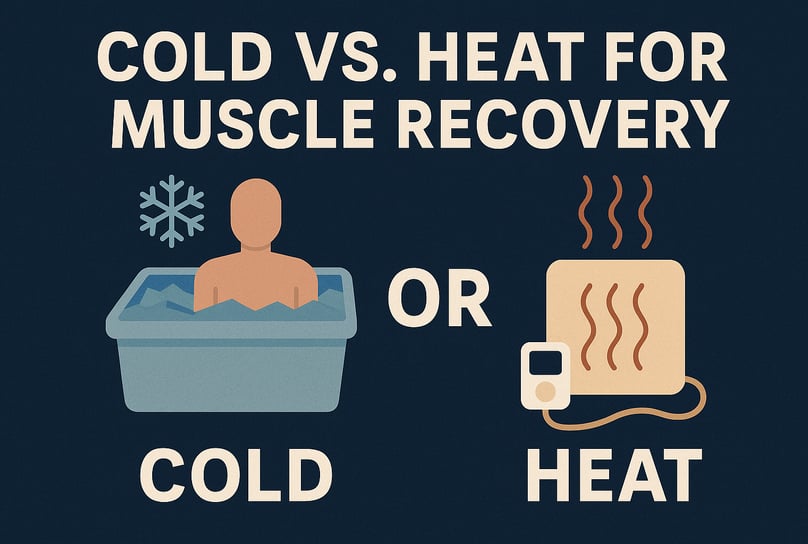Cold vs. Heat for Muscle Recovery: When to Use Ice, Heat, or Both
Not sure when to use ice baths, heat packs, or contrast therapy? This in-depth guide breaks down how and when to apply cold or heat to reduce soreness, manage inflammation, and speed up recovery. Learn what actually works—and why.
5/23/20253 min read


Cold vs. Heat: When to Use Which for Muscle Recovery
Whether you're sore from a hard session, nursing an injury, or trying to peak for performance, knowing when to use cold, heat, or both is a savvy move. Let’s break it down so you can optimize your recovery—and feel better, faster.
Cold Therapy: Ice Baths & Cryotherapy
When to use it: Immediately after super intense workouts, long endurance efforts, or to combat acute inflammation (think: swelling, sharp pain, stiffness).
How it works: Cold constricts blood vessels, slows metabolic processes, and blunts inflammation. Many athletes use ice baths (50–59 °F for 5–10 minutes) to reduce soreness and enhance recovery for subsequent sessions.People.comMen's Health
Benefits:
Reduces muscle soreness (DOMS)
Calms inflammation and swelling
May temporarily improve mood and alertnessPeople.com
Drawbacks:
Not ideal for strength adaptations immediately post-training—too much cold too soon can blunt muscle growth.
Can feel intense or uncomfortable, especially without insulation or gradual immersion.
Product we recommend: Home Cold Plunge Tub
110 Gal Portable Foldable Ice Bath Tub
Durable, insulated, and collapsible—great for athletes with space constraints Amazon
Why it’s useful: Maintain a consistent cold temp without needing ice constantly
Best for: Full-body immersion, convenient cold therapy at home
Heat Therapy: Heat Packs & Saunas
When to use it: Before training to warm up stiff muscles, or after initial inflammation subsides (24–48 hours post-exercise). Great for chronic aches, tight joints, or soothing soreness between hard sessions.
How it works: Heat dilates blood vessels, improving circulation, relaxing muscles, and boosting tissue elasticity. Whether through moist heat pads, saunas, or hot baths, it’s a go-to for prepping or recovering.
Benefits:
Alleviates muscle tension, improves flexibility
Speeds tissue repair via enhanced blood flow
Offers relaxing, calming relief
Drawbacks:
Avoid using on acute injuries—heat can worsen inflammation
Timing is key: don’t apply heat too early after intense sessions
Product we recommend: Electric Heating Pad
Pure Enrichment PureRelief XL Heating Pad
XL size, multiple heat settings, auto shut-off, and machine-washable cover Business Insider Amazon
Why it’s great: Offers moist or dry heat with safety features—ideal for targeted muscle recovery
Best for: Low-back, neck, shoulders—anywhere you need consistent, reliable warmth
Contrast Therapy & Combo Tools
What it is: Alternating hot and cold therapy—typically 1–3 minutes hot, followed by 30–60 seconds cold—repeated. The idea? The heat boosts blood flow, the cold constricts and reduces swelling—cycling this accelerates circulation and speeds removal of waste, potentially enhancing recovery.
Methods:
Manually transition between hot packs and ice packs
Use portable contrast therapy machines like RecoveryTherm Cube or Hyperice X units to automate temperature switching
Benefits:
Great for stubborn soreness, swelling, or chronic pain
Portable gear makes it easy at home or the gym
Drawbacks:
Some claim evidence is mixed; you may need to dial in timing and temp to find what works personally
Product we recommend: Contrast Therapy Device
Therabody RecoveryTherm Cube (Instant Contrast Machine)
Compact, wireless device offering controlled hot/cold cycles with preset modes Amazon
Why it’s smart: No-fuss, safe, and perfectly timed contrast therapy in one gadget
Best for: Athletes who need efficient, portable recovery—ideal for travel, gym, or turf
How To Use These Tools: A Smart Routine
Here’s a clear breakdown of when to use each method based on your situation:
Putting It Into Practice
Day of hard training or competition:
Cool-down → Cold therapy to reduce muscle damage and soreness
24–48 hours later:
Do a contrast therapy session to ramp up circulation and promote recovery
Before your next session:
Apply heat (e.g., PureRelief pad or sauna) to loosen joints and prep muscles
Regular maintenance:
Alternate heat and cold—heat in the morning to wake up, cold at night to reduce inflammation
Final Thoughts
Cold therapy is your go-to for bottling down acute soreness and inflammation. Heat is best for prepping, relaxing, and improving range of motion. Contrast therapy combines both for circulatory benefits. The key is timing and consistency, not extremes.
With the right tools—ice baths, a quality heating pad, or a contrast device—you can craft a smart recovery routine that cuts soreness, supports performance, and speeds up rebound. Want help building your personal recovery plan? I can tailor recommendations based on your schedule and goals.


FITNESS
Nutrition
WellnesS
info@movebetterco.com
© 2025. All rights reserved | Privacy Policy | Terms & Conditions